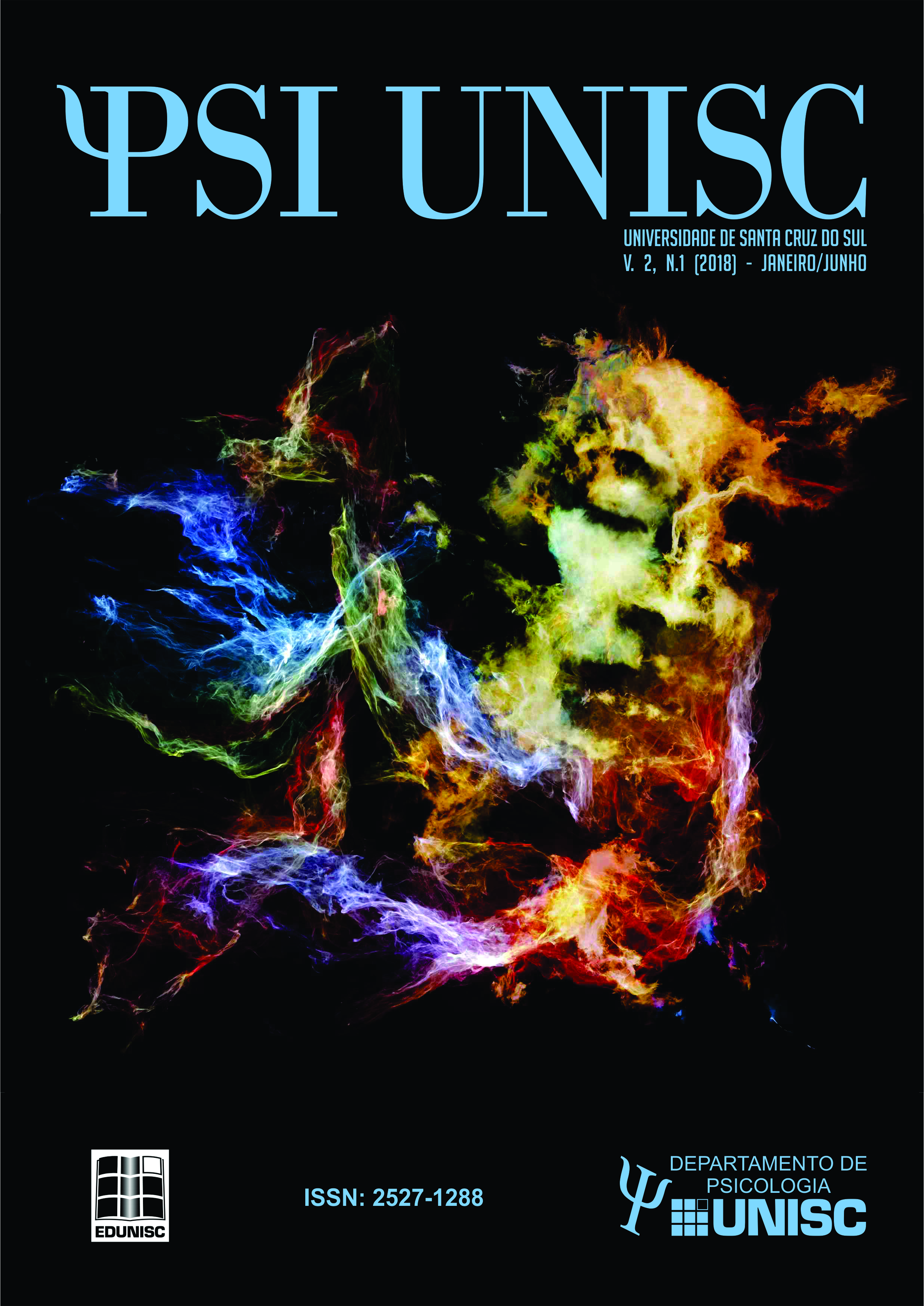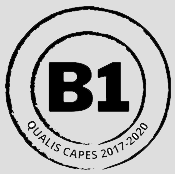Brief Guidance Program for Baby Caregivers: Assessment and Formulation
DOI:
https://doi.org/10.17058/psiunisc.v2i2.11125Keywords:
Preventive Programs. Caregiver Interaction – Baby. Shaken Baby SyndromeAbstract
Currently, the programs of Promotion and Prevention have gained space in the health area. One of these programs is Care-Well, created and carried out at a public university in Paraná-Brazil, which works with parents and caregivers of babies through the psychotherapy of topics such as childpositive interaction, child development, treatment and Vaulted Baby Syndrome SBS). This article sought to describe two moments of the program: its formulation and the evaluation of the results of its implementation, so its method, results and discussion present these two moments. The methodology used was qualitative and quantitative, of the exploratory type with intervention, pilot test and evaluation. The results show that, regarding the formulation of the program, this was done in stages. Some of examples of facilities of this process access to participants and difficulties the need to look for different short guidance formats. Regarding the evaluation, it was observed that the participants obtained an increase in the knowledge of the topics treated in the program, since the reports show an increase of the knowledge, especially in the subject SBS. The conclusion evidentiates that in the formulation and execution of prevention and promotion programs, the theoretical and technical support, as well as the sequence of steps suggested by the literature of the area that helps in its better organization, are fundamental, it is also concluded that The phase is because it allows additions to the characteristics of the program. Finally, through this report of experience, it is evident the possibility of carrying out university extension initiatives scientifically.Downloads
References
Antunes, C. (2011). Guia para estimulação do cérebro infantil: do nascimento aos 3 anos. 2. ed. Petropolis – RJ: Vozes.
Bardin, L. (2011). Análise de conteúdo. Lisboa: Edições 70.
Baumrind, D. (1966). Effects of authoritative parental control on child behavior. Child Development, Chicago, v. 37, p. 887-907.
Bee, H. (2011). A criança em desenvolvimento. Porto Alegre: Artes Medicas.
Berlinguer, G. (1994). Bioética da prevenção. Rev Bioética, 02, 117-122.
Brazelton, T.B. (1995). O Grande Livro da Criança. Lisboa: Editorial Presença.
Brasil. (1990). Lei nº 8.069 de 13 de julho de 1990. Dispõe sobre o Estatuto da Criança e do Adolescente e dá outras providências. Brasília, 13 de julho de 1990, Fernando Collor.
Brasil. (2001). Ministério da Saúde. Secretaria de Políticas de Saúde. Violência intrafamiliar: orientações para prática em serviço / Secretaria de Políticas de Saúde. Brasília: Ministério da Saúde.
Caminha, R. M.; Soares, T.; Kreitchmann, R.S. (2011). Intervenções Precoces: promovendo resiliência e saúde mental. In: Caminha, M. G.; Caminha, R. M.; et. al. Intervenções e treinamento de cuidadores na clínica infantil. Porto Alegre: Sinopsys, p. 31-79.
Campos, C.J.G. (2004). Método de Análise de Conteúdo: ferramenta para a análise de dados qualitativos no campo da saúde. Rev Bras Enferm, Brasília (DF) set/out;57(5):611-4.
Cardoso, A.C.A et al. (2003). Recomendações para o atendimento de crianças e adolescentes vítimas de violência física (maus tratos). Rev Pediatria Moderna. Vol. XXXIX. Nº 9. Set.
Carmo, P. H.B., Alvarenga, P. (2012). Práticas educativas coercitivas de mães de diferentes níveis socioeconômicos. Rev Estudos de Psicologia. 17(2), maio-agosto, 191-197
Case M.E.; Graham, M.A.; Handy, T.C.; Jentzen, J.M.; Monteleone, J.A. (2001). Position paper on fatal abusive head injuries in infants and young children. Am J Forensic Med Pathol. 2001; 22:112-22
Cecconello, A.M, Antoni, C, Koller, S.H. (2003). Práticas Educativas, Estilos Parentais e Abuso Físico no Contexto Familiar. Rev Psicologia em Estudo, Maringá, v. 8, p. 45-54.
Dumka, l. e et al. (1995). Using research and theory to develop prevention programs for high-risk families. family relations, p. 78-86.
Especialista ensina a identificar a razão do choro do bebê. 2015. disponível em: <http://tvuol.uol.com.br/video/especialista-ensina-a-identificar-a-razao-do-choro-do-bebe-04020d99346ae0995326>. Acesso em 10 set 2015.
Foley, S.; Kova´cs, Z.; Rose, J.; Lamb, R.; Tolliday, F.; Simons-Coghill, M.; Stephens, A. Scheiber, D.; Toma, A. Asbo'th, K. Kassai, T. Agathonos, H. Lopes, N.R.L.; Williams, L.C.A.; Sahin, F.; Tasar, A.; Sarten, T. (2013). International collaboration on prevention of shaken baby syndrome – an ongoing project/intervention. Paediatrics and International Child Health. v. 33 N.4
Gil, M.S.C.A, Oliveira, T.P, Sousa, N.M. (2012). Desenvolvimento Humano. In: Hubner, M.M.C, Moreira, M.B (Org). Fundamentos de Psicologia: Temas Clássicos da Psicologia sob a Ótica da Análise do Comportamento. Rio de Janeiro: Guanabara Koogan.
Graça, P.R.M., Teixeira,M. L. C., Lopes, S.C.G., Serrano, A.M.S.P.H., Campos, A.R.S (2010). O Momento da Avaliação na Intervenção Precoce: O Envolvimento da Família Estudo das Qualidades Psicométricas do Asq-2 dos 30 aos 60 Meses. Rev. Bras. Ed. Esp., Marília, v.16, n.2, p.177-196, Mai.-Ago.
Hennes H, Kini N, Palusci VJ. (2001). The epidemiology, clinical characteristics and public health implications of Shaken Baby Syndrome. In: Lazoritz S, Palusci VJ, editors. The Shaken Baby Syndrome: A multidisciplinary approach. Binghamton: The Haworth Maltreatment & Trauma Press; 2001, p. 19-40.
Kempe, C.R., Denver, F.N.S., Cincinnati, B.T.S., Droegemueller, W., Silver, H.K (1985). The Battered-Child Sindrome. Child Abuse & Neglect, vol 9, pp. 143 – 154.
Lohr, S. S.; Pereira, A.C.S.; Andrade, A.L.M.; Kirchner, L.F. Avaliação de Programas Preventivos: relatos de experiência. Rev Psicologia em Estudo, v.12, n.3, p. 641-649, set/dez. 2007.
Lopes, N.R.L. Trauma Craniano Violento: Conhecimento Parental e Avaliação de Material Informativo. Dissertação (Mestrado em Psicologia) – Universidade Federal de São Carlos. São Carlos: UFSCar, 2013. 130 p.
Maia, J.M.D; Williams, L.C.A. (2005). Fatores de Risco e Fatores de Proteção ao desenvolvimento infantil: uma revisão da área. Rev Temas em Psicologia, vol 13, nº 2, 91-103.
Marinho, M. L. (2000). A intervenção clínica comportamental com famílias. In E. F. M. Silvares (Org.), Estudos de caso em psicologia clínica comportamental infantil. Campinas: Papirus.
Moreira, M. F.; Nóbrega, M. M. L.; Silva, M. I. T. (2003). Comunicação escrita: contribuição para a elaboração de material educativo em saúde. Rev. Bras. Enferm., Brasília (DF), 56(2): 184-8.
Não sacuda seu bebê (Síndrome do bebe sacudido). (2009). Realizador LAPREV (Laboratório de Analise e Prevenção a Violência). Local: São Carlos - São Paulo. (3:40 min), son, color. Disponível em: <https://www.youtube.com/watch?v=o0vASBX8CQ0> Acesso em: 07 Jul 2015.
Organização Mundial da Saúde. (2001). Prevenção e Promoção em Saúde Mental. Genebra: OMS.
Papalia, D.E.; Feldman, R.D (2013). Desenvolvimento Humano. 12 Ed. Porto-Alegre: AMGH.
Pelaez, M., Novak, G (2004). Child and adolescente develoment: A Behavioral Systems Approach. London: Sage Publications.
Pereira, A.C.S., Dittrich, A. (2007). O conceito de Prevenção para o behaviorismo radical: em busca de práticas preventivas de maior sucesso. In: STARLING, R.R. Sobre Comportamento e Cognição: temas aplicados. Santo André-SP: ESETec Editores Associados.
Pinheiro, M.I.S., Haase, V.G. (2012). Treinamento de Cuidadores: Programas de Intervenção. In: Baptista, M.K, Teodoro, M.LM. Psicologia de Família: Teoria, Avaliação e Intervenção. Porto-Alegre: Artmed.
Plenário do Conselho Nacional de Saúde (2012). Aprova as seguintes diretrizes e normas regulamentadoras de pesquisas envolvendo seres humanos. Resolução n 466, de 12 de dezembro de 2012.
Soejima, C.S., Bolsanello, M. A. (2012). Programa de intervenção e atenção com bebês na Educação Infantil. Educar em Revista, Ed. UFPR, Curitiba, PR, n. 43, p. 65-79, jan./mar.
Weber, L.N.D. Interações entre Família e Desenvolvimento. (2008). In: Weber, L.N.D (Org) Família e Desenvolvimento: Visões Interdisciplinares. Curitiba: Jurua.
Williams, L. C. A., Habigzang, L. F (2014). Crianças e Adolescentes vítimas de violência: Prevenção, avaliação e intervenção. Curitiba: Juruá.
Downloads
Published
How to Cite
Issue
Section
License
The submission of originals to this journal implies the transfer, by the authors, of the printed and digital publication rights. The copyrights for the published articles are those of the author, with periodical rights on the first publication. Authors may only use the same results in other publications clearly indicating this journal as the medium of the original publication. Because we are an open access journal, we allow free use of articles in educational and scientific applications provided the source is cited under the Creative Commons CC-BY license.




